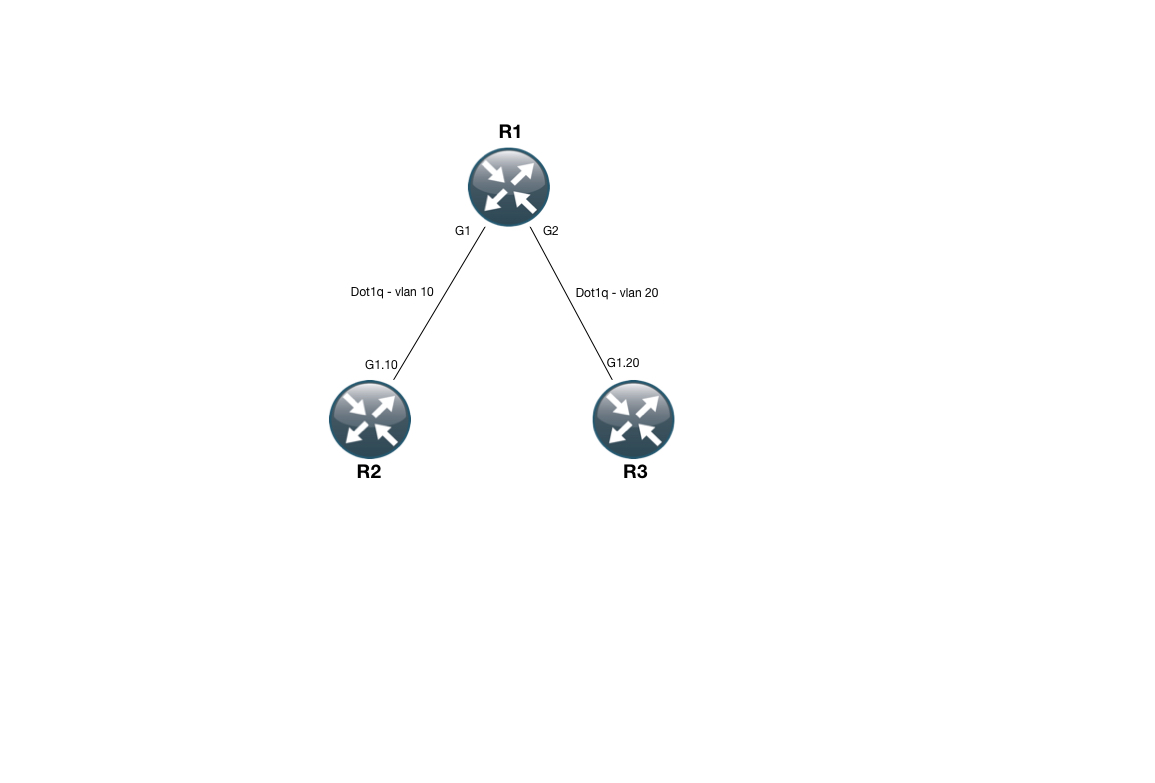Snippet: The story of the EFP
For a while now, the concept of EVC’s (Ethernet Virtual Circuits) and EFP’s (Ethernet Flow Points), has eluded me.
In this short post, i will provide you with a simple example of a couple of EFP’s. In a later post i will discuss the MEF concept of EVC’s.
As always, here is the topology i will be using:
Its a very simple setup. R1 connects to R2 through its G1 interface and connects to R3 through its G2 interface.
On R2 and R3, we have the very common configuration of using subinterfaces for the individual Vlan’s in question. Namely Vlan 10 for the connection between R1 and R2 and Vlan 20 between R1 and R3.
Here is the configuration of R2 and R3:
R2#sh run int g1.10 Building configuration... Current configuration : 98 bytes ! interface GigabitEthernet1.10 encapsulation dot1Q 10 ip address 10.10.10.2 255.255.255.0 end R3#sh run int g1.20 Building configuration... Current configuration : 98 bytes ! interface GigabitEthernet1.20 encapsulation dot1Q 20 ip address 10.10.10.3 255.255.255.0 end
Now on R1 is where the “different” configuration takes place:
R1#sh run int g1 Building configuration... Current configuration : 182 bytes ! interface GigabitEthernet1 no ip address negotiation auto service instance 10 ethernet encapsulation dot1q 10 rewrite ingress tag pop 1 symmetric bridge-domain 10 ! end R1#sh run int g2 Building configuration... Current configuration : 182 bytes ! interface GigabitEthernet2 no ip address negotiation auto service instance 20 ethernet encapsulation dot1q 20 rewrite ingress tag pop 1 symmetric bridge-domain 10 ! end R1#sh run int bdi10 Building configuration... Current configuration : 96 bytes ! interface BDI10 description -= Our L3 interface =- ip address 10.10.10.1 255.255.255.0 end
So what does this all mean!? – Well, basically what you are looking at is the very nature of an EFP. One on each physical interface in this case. It is defined under the “service instance” command structure.
An Ethernet Flow Point (EFP) is a way to match a certain ethernet frame, do an action on it ingress (and also in our case egress). On top of that you can attach it to a bridge-domain.
The result of the above configuration is that on G1, we match on the dot1q tag when its tagged with vlan 10. On ingress we then pop 1 tag before performing any other “upstream” action. With the symmetric keyword, we attach the vlan 10 tag when egressing.
On G2, we are doing the same, but with vlan 20 instead.
With both EFP’s we attach a bridge-domain (ID 10), which can be verified like this:
R1#show bridge-domain Bridge-domain 10 (3 ports in all) State: UP Mac learning: Enabled Aging-Timer: 300 second(s) BDI10 (up) GigabitEthernet1 service instance 10 GigabitEthernet2 service instance 20 AED MAC address Policy Tag Age Pseudoport - 001E.7AE0.11BF to_bdi static 0 BDI10
Right now we only have one mac address learned, namely of our L3 BDI interface. But we can see that both G1 and G2 has a service instance in this bridge-domain.
Lets try and do some ICMP tests from R2:
R2#ping 10.10.10.1 Type escape sequence to abort. Sending 5, 100-byte ICMP Echos to 10.10.10.1, timeout is 2 seconds: !!!!! Success rate is 100 percent (5/5), round-trip min/avg/max = 1/120/598 ms
Lets again verify our bridge-domain on R1:
R1#show bridge-domain Bridge-domain 10 (3 ports in all) State: UP Mac learning: Enabled Aging-Timer: 300 second(s) BDI10 (up) GigabitEthernet1 service instance 10 GigabitEthernet2 service instance 20 AED MAC address Policy Tag Age Pseudoport - 001E.7AE0.11BF to_bdi static 0 BDI10 0 0050.56BE.18D8 forward dynamic 276 GigabitEthernet1.EFP10
What we see now, is that a Mac address has been dynamically learned through the G1.EFP10 EFP.
Since we are technically “bridging” these two distinct vlans, we should be able to ping R3 from R2 as well:
R2#ping 10.10.10.3 Type escape sequence to abort. Sending 5, 100-byte ICMP Echos to 10.10.10.3, timeout is 2 seconds: !!!!! Success rate is 100 percent (5/5), round-trip min/avg/max = 2/24/104 ms
And again on R1:
R1#show bridge-domain Bridge-domain 10 (3 ports in all) State: UP Mac learning: Enabled Aging-Timer: 300 second(s) BDI10 (up) GigabitEthernet1 service instance 10 GigabitEthernet2 service instance 20 AED MAC address Policy Tag Age Pseudoport - 001E.7AE0.11BF to_bdi static 0 BDI10 0 0050.56BE.320A forward dynamic 287 GigabitEthernet2.EFP20 0 0050.56BE.18D8 forward dynamic 287 GigabitEthernet1.EFP10
We have now learned all the Mac addresses in our small test environment.
So thats basically all there is to an EFP. A simple way of providing a flexible way of matching frames.
Until next time! – Take care.
